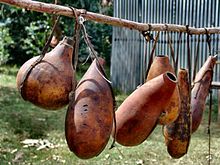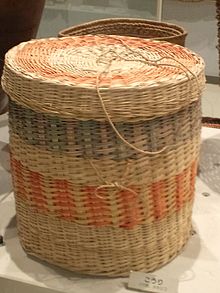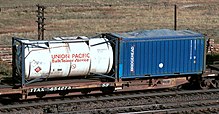Containers Online Tutorials
A container is any receptacle or enclosure for holding a product used in storage, packaging, and transportation, including shipping. Things kept inside of a container are protected on several sides by being inside of its structure. The term is most frequently applied to devices made from materials that are durable and are often partly or completely rigid.





A container can also be considered as a basic tool, consisting of any device creating a partially or fully enclosed space that can be used to contain, store, and transport objects or materials.
History edit
Humans have used containers for at least 100,000 years, and possibly for millions of years. The first containers were probably invented for storing food, allowing early humans to preserve more of their food for a longer time, to carry it more easily, and also to protect it from other animals. The development of food storage containers was "of immense importance to the evolving human populations", and "was a totally innovative behavior" not seen in other primates. The earliest containers were probably objects found in nature such as hollow gourds, of which primitive examples have been found in cultures such as those of the Tharu people, and native Hawaiian people. These were followed by woven baskets, carved wood, and pottery.
Containers thereafter continued to develop along with related advances in human technology, and with the development of new materials and new means of manufacture.[10] Early glass bottles were produced by the Phoenicians; specimens of Phoenician translucent and transparent glass bottles have been found in Cyprus and Rhodes generally varying in length from three to six inches.[11] These Phoenician examples from the first millennium BC were thought to have been used to contain perfume.[12] The Romans learned glass-making from the Phoenicians and produced many extant examples of fine glass bottles, mostly relatively small. By the beginning of the eighteenth century, sizes for retail containers such as glass bottles had become standardized for their markets.[13]
In 1810, Frenchman Philippe de Girard came to London and used British merchant Peter Durand as an agent to patent his own idea for a process for making tin cans.[14] The canning concept was based on experimental food preservation work in glass containers the year before by the French inventor Nicholas Appert. Durand did not pursue food canning, but, in 1812, sold his patent to two Englishmen, Bryan Donkin and John Hall, who refined the process and product, and set up the world's first commercial canning factory on Southwark Park Road, London. By 1813 they were producing their first tin canned goods for the Royal Navy.
For transportation of goods on a larger scale, larger containers remained a problem, as customs officials inspecting imports had to deal with a lack of standardization in this field, and because predominantly wooden containers in use well into the twentieth century were prone to leaking or breaking.[13] The standardized steel shipping container was developed in the 1950s, and quickly became ubiquitous for the large-scale transportation of commercial goods.
Towards the end of the Twentieth century, the introduction of computer-aided design made it possible to design highly specialized containers and container arrangements, and also to make form-fitting labels for containers of unusual shapes.[15]
Modern characteristics edit
A number of considerations go into the design of modern containers:
The product characteristics that create utility for a container go beyond just providing shock and moisture protection for the contents. A well-designed container will also exhibit ease of use, that is, it is easy for the worker to open or close, to insert or extract the contents, and to handle the container in shipment. In addition, a good container will have convenient and legible labeling locations, a shape that is conducive to efficient stacking and storing, and easy recycling at the end of its useful life.[16]
Variety edit
Practical examples of containers are listed below.
- Ceramic cylindrical vessels including:
- Ancient vessels, including Amphoras, Kvevri, Pithos, and Dolium
- Bottles, similar to a jar in being traditionally symmetrical about the axis perpendicular to its base and made of glass
- Jars, traditionally cylindrical and made of glass
- Cylindrical vessels including:
- Barrels, made of wooden staves bound by rope, wooden or metal hoops.
- Cans, traditionally cylindrical and sheet-metallic.
- Drums, similar to a can but definitely cylindrical and not necessarily metallic
- Tub
- Rectilinear vessels including:
- Boxes
- Crates, a box or rectilinear exoskeleton, designed for hoisting or loading
- Wooden boxes
- Lift-vans
- Corf
- Certain waste containers
- Flexible containers including:
- Bags, such as shopping bags, mail bags, sick bag
- Luggage, including satchels, backpacks, and briefcases
- Packets
- Gunny sacks, flour sacks
- Wallets
- Shipping containers, including:
- Corrugated boxes, made of corrugated fiberboard
- Intermodal containers, a.k.a. ship container or cargo container
- Twenty-foot equivalent units, an industry standard intermodal container size
- Intermediate bulk containers
- Unit load devices, similar to a crate
- Flexible intermediate bulk containers
Containers Tutorials: A container is a class, a data structure, or an abstract data type whose instances are collections of other objects. Containers typically make use of generics or templates so that a wide variety of objects can be added.
Latest online Containers Tutorials with example so this page for both freshers and experienced candidate who want to get job in Containers company
Latest online Containers Tutorials for both freshers and experienced
advertisementsView Tutorials on Containers 
- 6 >Hyderabad
- 7 >Kolkata
- 8 >Kochi
- 9 >Ahmedabad
- 10 >Trivandrum
- 11 >Bhubaneshwar
- 12 >Indore
- 13 >Coimbatore
- 14 >Goa
- .Net Interview Questions And Answers
- All Interview Questions And Answers
- Android Common Tips Q and Ans
- AJAX Interview Questions And Answers
- Codeigniter Interview Questions And Answers
- Aptitude Interview Questions And Answers
- C Interview Questions And Answers
- CSS3 Interview Questions And Answers
- Data Structure Questions With Answers
- Database (DBMS) Questions With Answers
- Drupal Interview Questions And Answers
- Download Career Guide in doc file
- Dojo Interview Questions And Answers
- Design Pattern of all type
- EJB Interview Questions And Answers
- Header Function use in PHP and HTTP
- HR Interview Questions And Answers
- HTML5 Interview Questions And Answers
- Joomla Interview Questions And Answers
- Iphone Interview Questions And Answers
- MYSQL Interview Questions And Answers
- Java Interview Questions And Answers
- JQuery Interview Questions And Answers
- JSON Interview Questions And Answers
- JSP Interview Questions And Answers
- linux Commands and Interview Questions
- Moodle Tutorial for Developers
- Magento Common Tips Q and Ans
- Networking Hardware Questions with Answers
- Operating Systems Interview Questions
- OOPs Interview Questions and Answers
- PHP Interview Questions And Answers
- PHP Interview Questions 1500+
- PHP All Objective Questions Answers
- PHP Jobs for freshers and experienced
- Project Management Interview questions
- Regular Expressions Interview questions
- Spring Interview Questions Answers In Java
- Software Testing Interview Questions Answer
- Servlets Interview Questions And Answers
- Struts Interview Questions And Answers
- Threads Interview Questions And Answers
- US Jobs city Wise
- All Indian Company Name List
- Web Designing Interview Questions Answers
- XML Interview Questions Answers
- XML Interview Questions Answers
- .net Interview Questions And Answers
- Accountant Interview Questions And Answers
- Ado.net Interview Questions And Answers
- Adp Interview Questions And Answers
- Agile Methodology Interview Questions And Answers
- Android Interview Questions And Answers
- Apache Interview Questions And Answers
- Application Packaging Interview Questions And Answers
- Asp Interview Questions And Answers
- Backbone.js Interview Questions And Answers
- C Sharp Interview Questions And Answers
- C++ Interview Questions And Answers
- Cake Interview Questions And Answers
- Cakephp Interview Questions And Answers
- Can Protocol Interview Questions And Answers
- Catia V5 Interview Questions And Answers
- Ccna Interview Questions And Answers
- Checkpoint Firewall Interview Questions And Answers
- Control M Interview Questions And Answers
- Cpp Interview Questions And Answers
- Css Interview Questions And Answers
- DATA GRID Interview Questions And Answers
- Data Warehouse Interview Questions And Answers
- Data Structures Interview Questions And Answers
- Database Interview Questions And Answers
- Db2 Interview Questions And Answers
- Desktop Engineer Interview Questions And Answers
- Desktop Support Interview Questions And Answers
- DOJO Interview Questions And Answers
- Electrical Engineering Interview Questions And Answers
- Embedded Systems Interview Questions And Answers
- Hadoop Interview Questions And Answers
- Hibernate Interview Questions And Answers
- J2ee Interview Questions And Answers
- Javascript Interview Questions And Answers
- Joomla Interview Questions And Answers
- Jsp Interview Questions And Answers
- Less Interview Questions And Answers
- Linq Interview Questions And Answers
- Linux Interview Questions And Answers
- Matlab Interview Questions And Answers
- Mcitp Interview Questions And Answers
- Netbackup Interview Questions And Answers
- Node.js Interview Questions And Answers
- Oracle Interview Questions And Answers
- Perl Interview Questions And Answers
- Plsql Interview Questions And Answers
- Postgresql Interview Questions And Answers
- Python Interview Questions And Answers
- Qa Testing Interview Questions And Answers
- Qtp Interview Questions And Answers
- Sap Interview Questions And Answers
- Sass Interview Questions And Answers
- Selenium Interview Questions And Answers
- SEO Interview Questions And Answers
- Sharepoint Interview Questions And Answers
- Silverlight Interview Questions And Answers
- Sql Dba Interview Questions And Answers
- String Interview Questions And Answers
- Struts2 Interview Questions And Answers
- Stware Testing Interview Questions And Answers
- Swing Interview Questions And Answers
- Technical Support Interview Questions And Answers
- Telecom Billing Interview Questions And Answers
- Tomcat Interview Questions And Answers
- Troubleshooting Interview Questions And Answers
- Uml Interview Questions And Answers
- Us Visa Interview Questions And Answers
- Vb Interview Questions And Answers
- Visa Interview Questions And Answers
- Wcf Interview Questions And Answers
- Web Testing Interview Questions And Answers
- Windows Interview Questions And Answers
- Wordpress Interview Questions And Answers
- Wpf Interview Questions And Answers
- XQuery Interview Questions And Answers
- Yii Interview Questions And Answers
- Zend Framework 2 Interview Questions And Answers
- Zend Framework Interview Questions And Answers